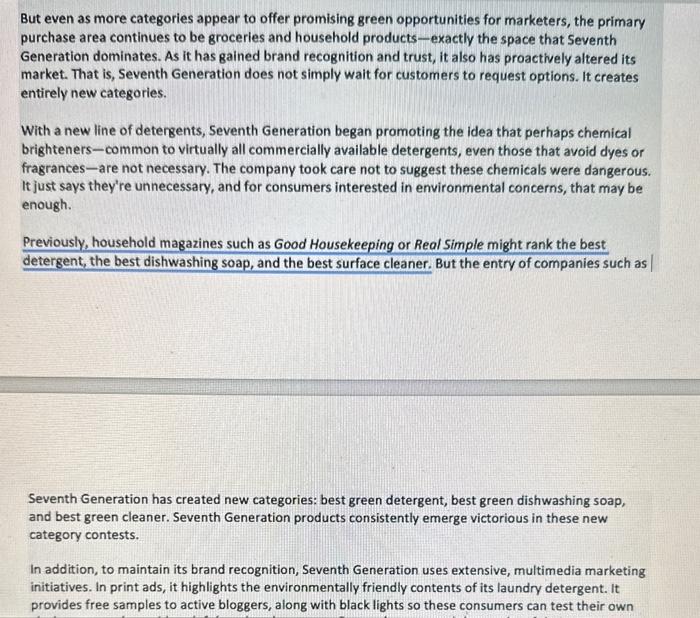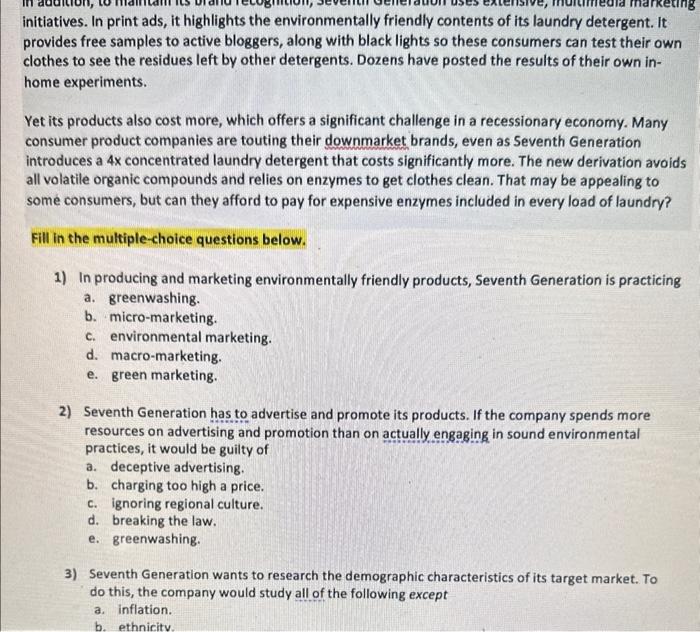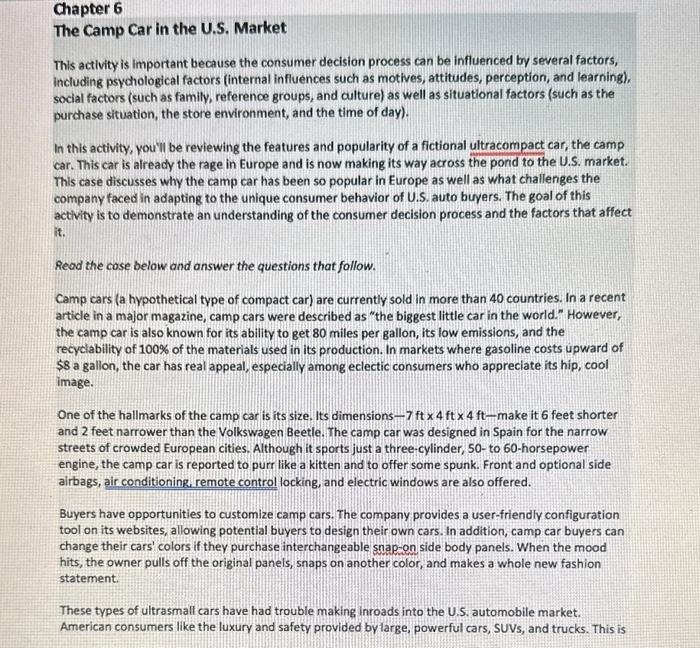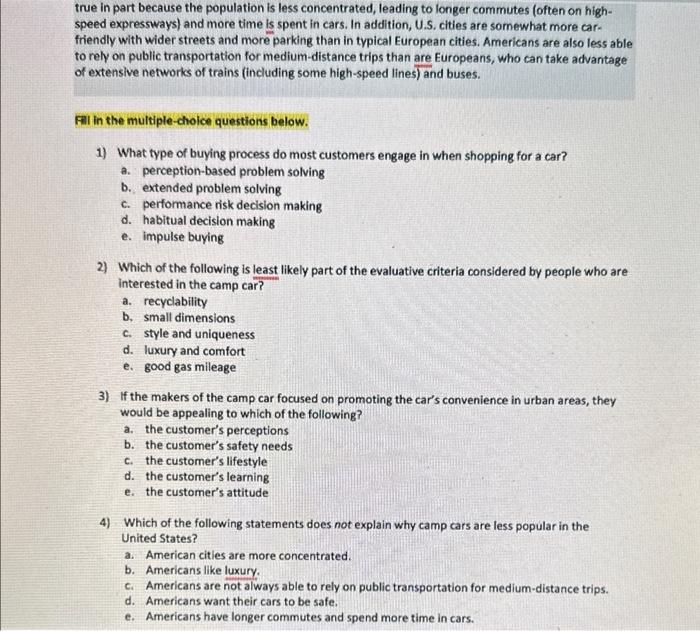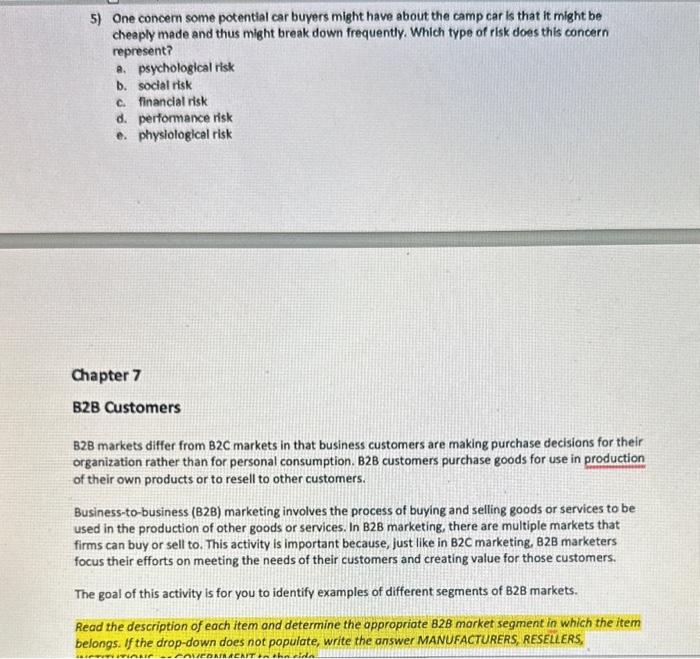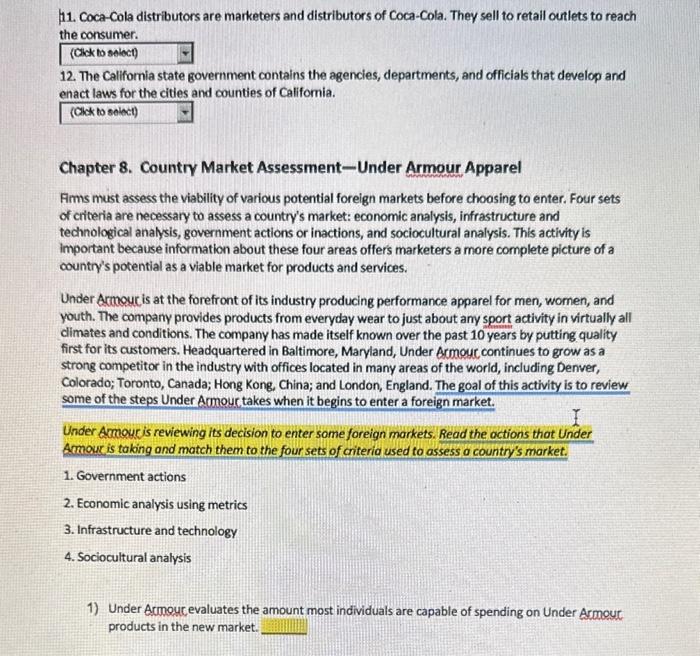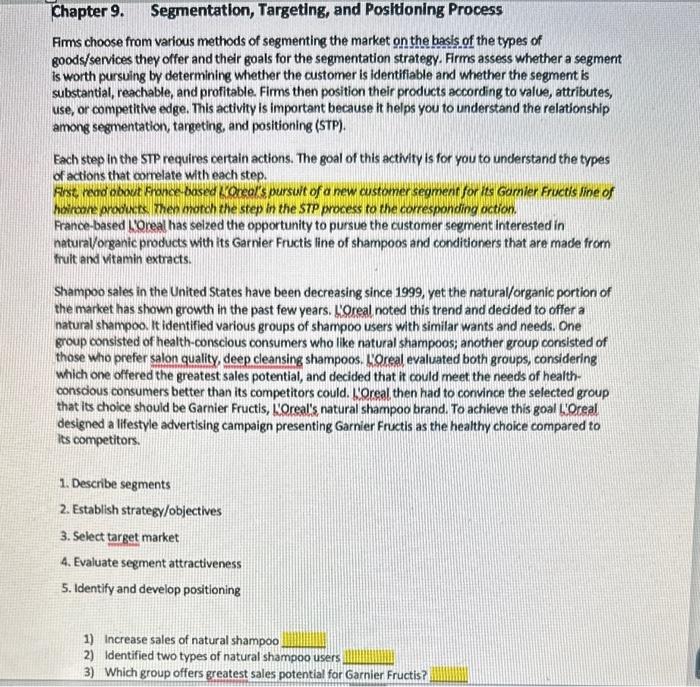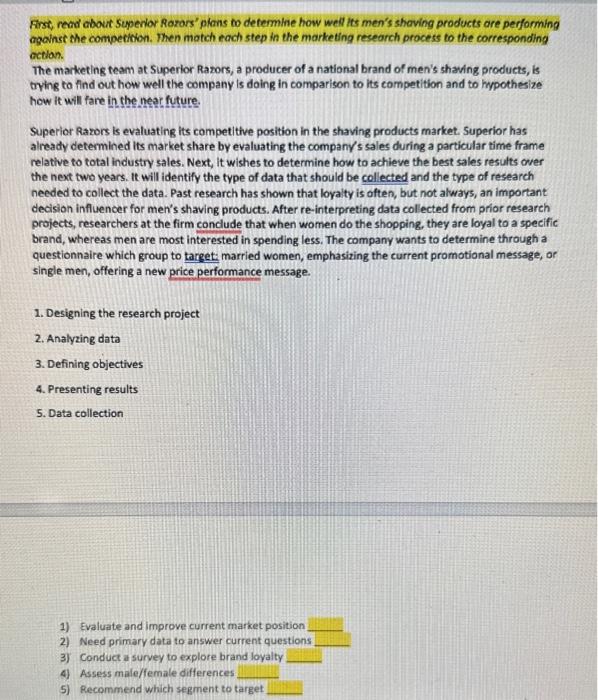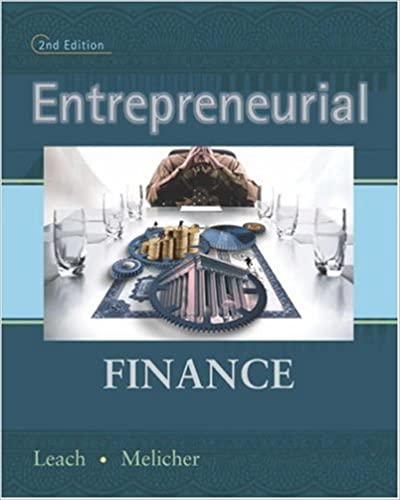Will you please answe it by order, I would really appreciate that, thank you
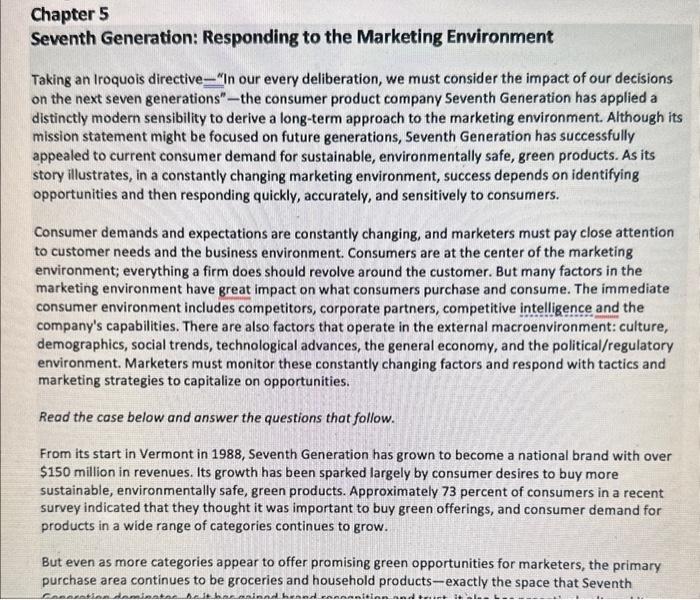
Seventh Generation: Responding to the Marketing Environment Taking an Iroquois directive - "In our every deliberation, we must consider the impact of our decisions on the next seven generations" - the consumer product company Seventh Generation has applied a distinctly modern sensibility to derive a long-term approach to the marketing environment. Although its mission statement might be focused on future generations, Seventh Generation has successfully appealed to current consumer demand for sustainable, environmentally safe, green products. As its story illustrates, in a constantly changing marketing environment, success depends on identifying opportunities and then responding quickly, accurately, and sensitively to consumers. Consumer demands and expectations are constantly changing, and marketers must pay close attention to customer needs and the business environment. Consumers are at the center of the marketing environment; everything a firm does should revolve around the customer. But many factors in the marketing environment have great impact on what consumers purchase and consume. The immediate consumer environment includes competitors, corporate partners, competitive intelligence and the company's capabilities. There are also factors that operate in the external macroenvironment: culture, demographics, social trends, technological advances, the general economy, and the political/regulatory environment. Marketers must monitor these constantly changing factors and respond with tactics and marketing strategies to capitalize on opportunities. Read the case below and answer the questions that follow. From its start in Vermont in 1988, Seventh Generation has grown to become a national brand with over $150 million in revenues. Its growth has been sparked largely by consumer desires to buy more sustainable, environmentally safe, green products. Approximately 73 percent of consumers in a recent survey indicated that they thought it was important to buy green offerings, and consumer demand for products in a wide range of categories continues to grow. But even as more categories appear to offer promising green opportunities for marketers, the primary purchase area continues to be groceries and household products-exactly the space that Seventh But even as more categories appear to offer promising green opportunities for marketers, the primary purchase area continues to be groceries and household products - exactly the space that Seventh Generation dominates. As it has gained brand recognition and trust, it also has proactively altered its market. That is, Seventh Generation does not simply wait for customers to request options. It creates entirely new categories. With a new line of detergents, Seventh Generation began promoting the idea that perhaps chemical brighteners-common to virtually all commercially available detergents, even those that avoid dyes or fragrances-are not necessary. The company took care not to suggest these chemicals were dangerous. It just says they're unnecessary, and for consumers interested in environmental concerns, that may be enough. Previously, household magazines such as Good Housekeeping or Real Simple might rank the best detergent, the best dishwashing soap, and the best surface cleaner. But the entry of companies such as| Seventh Generation has created new categories: best green detergent, best green dishwashing soap, and best green cleaner. Seventh Generation products consistently emerge victorious in these new category contests. In addition, to maintain its brand recognition, Seventh Generation uses extensive, multimedia marketing initiatives. In print ads, it highlights the environmentally friendly contents of its laundry detergent. It provides free samples to active bloggers, along with black lights so these consumers can test their own initiatives. In print ads, it highlights the environmentally friendly contents of its laundry detergent. It provides free samples to active bloggers, along with black lights so these consumers can test their own clothes to see the residues left by other detergents. Dozens have posted the results of their own inhome experiments. Yet its products also cost more, which offers a significant challenge in a recessionary economy. Many consumer product companies are touting their downmarket brands, even as Seventh Generation introduces a 4x concentrated laundry detergent that costs significantly more. The new derivation avoids all volatile organic compounds and relies on enzymes to get clothes clean. That may be appealing to some consumers, but can they afford to pay for expensive enzymes included in every load of laundry? Fill in the multiple-choice questions below. 1) In producing and marketing environmentally friendly products, Seventh Generation is practicing a. greenwashing. b. micro-marketing. c. environmental marketing. d. macro-marketing. e. green marketing. 2) Seventh Generation has to advertise and promote its products. If the company spends more resources on advertising and promotion than on actually engaging in sound environmental practices, it would be guilty of a. deceptive advertising. b. charging too high a price. c. ignoring regional culture. d. breaking the law. e. greenwashing. 3) Seventh Generation wants to research the demographic characteristics of its target market. To do this, the company would study all of the following except a. inflation. 3) Seventh Generation wants to research the demographic characteristics of its target market. To do this, the company would study all of the following except a. inflation. b. ethnicity. c. income. d. gender. 4) The green movement represents which factor in the marketing environment? a. demographics b. social trends c. generational cohorts d. regional culture e. technology advances 5) If Seventh Generation were analyzing the consumers' immediate environment, which of the following would it study and research? a. country culture b. social trends c. inflation and interest rates d. competitors e. regional culture Chapter 6 The Camp Car in the U.S. Market This activity is important because the consumer decision process can be influenced by several factors, including psychological factors (internal influences such as motives, attitudes, perception, and learning), social factors (such as family, reference groups, and culture) as well as situational factors (such as the purchase situation, the store environment, and the time of day). In this activity, you'll be reviewing the features and popularity of a fictional ultracompact car, the camp car. This car is already the rage in Europe and is now making its way across the pond to the U.S. market. This case discusses why the camp car has been so popular in Europe as well as what challenges the company faced in adapting to the unique consumer behavior of U.S. auto buyers. The goal of this activity is to demonstrate an understanding of the consumer decision process and the factors that affect it. Read the cose below and answer the questions that follow. Camp cars (a hypothetical type of compact car) are currently sold in more than 40 countries. In a recent article in a major magazine, camp cars were described as "the biggest little car in the world." However, the camp car is also known for its ability to get 80 miles per gallon, its low emissions, and the recyclability of 100% of the materials used in its production. In markets where gasoline costs upward of $8 a gallon, the car has real appeal, especially among eclectic consumers who appreciate its hip, cool image. One of the hallmarks of the camp car is its size. Its dimensions 7ft4ft4ft make it 6 feet shorter and 2 feet narrower than the Volkswagen Beetle. The camp car was designed in Spain for the narrow streets of crowded European cities. Although it sports just a three-cylinder, 50-to 60 -horsepower engine, the camp car is reported to purr like a kitten and to offer some spunk. Front and optional side airbags, air conditioning, remote control locking, and electric windows are also offered. Buyers have opportunities to customize camp cars. The company provides a user-friendly configuration tool on its websites, allowing potential buyers to design their own cars. In addition, camp car buyers can change their cars' colors if they purchase interchangeable snap-on side body panels. When the mood hits, the owner pulls off the original panels, snaps on another color, and makes a whole new fashion statement. These types of ultrasmall cars have had trouble making inroads into the U.S. automobile market. American consumers like the luxury and safety provided by large, powerful cars, SUVs, and trucks. This is true in part because the population is less concentrated, leading to longer commutes (often on highspeed expressways) and more time is spent in cars. In addition, U.S. cities are somewhat more carfriendly with wider streets and more parking than in typical European cities. Americans are also less able to rely on public transportation for medium-distance trips than are Europeans, who can take advantage of extensive networks of trains (including some high-speed lines) and buses. Fil in the multiple-cholce questions below. 1) What type of buying process do most customers engage in when shopping for a car? a. perception-based problem solving b. extended problem solving c. performance risk decision making d. habitual decision making e. impulse buying 2) Which of the following is least likely part of the evaluative criteria considered by people who are interested in the camp car? a. recyclability b. small dimensions c. style and uniqueness d. luxury and comfort e. good gas mileage 3) If the makers of the camp car focused on promoting the car's convenience in urban areas, they would be appealing to which of the following? a. the customer's perceptions b. the customer's safety needs c. the customer's lifestyle d. the customer's learning e. the customer's attitude 4) Which of the following statements does not explain why camp cars are less popular in the United States? a. American cities are more concentrated. b. Americans like luxury. c. Americans are not always able to rely on public transportation for medium-distance trips. d. Americans want their cars to be safe. e. Americans have longer commutes and spend more time in cars. 5) One concern some potential car buyers might have about the camp car is that it might be cheaply made and thus might break down frequently. Which type of risk does this concern represent? a. psychological risk b. social risk c. financial risk d. performance risk e. Physiological risk Chapter 7 B2B Customers B2B markets differ from B2C markets in that business customers are making purchase decisions for their organization rather than for personal consumption. B2B customers purchase goods for use in production of their own products or to resell to other customers. Business-to-business (B2B) marketing involves the process of buying and selling goods or services to be used in the production of other goods or services. In B2B marketing, there are multiple markets that firms can buy or sell to. This activity is important because, just like in B2C marketing, B2B marketers focus their efforts on meeting the needs of their customers and creating value for those customers. The goal of this activity is for you to identify examples of different segments of B2B markets. Read the description of each item and determine the appropriote B2B market segment in which the item belongs. If the drop-down does not populate, write the answer MANUFACTURERS, RESELIERS, B2B Customers B2B markets differ from B2C markets in that business customers are making purchase decisions for their organization rather than for personal consumption. B2B customers purchase goods for use in production of their own products or to resell to other customers. Business-to-business (B2B) marketing involves the process of buying and selling goods or services to be used in the production of other goods or services. In B2B marketing, there are multiple markets that firms can buy or sell to. This activity is important because, just like in B2C marketing, B2B marketers focus their efforts on meeting the needs of their customers and creating value for those customers. The goal of this activity is for you to identify examples of different segments of B2B markets. Read the description of each item and determine the appropriate B2B market segment in which the item belongs. If the drop-down does not populate, write the answer MANUFACTURERS, RESELLERS, INSTITUTIONS, or GOVERNMENT to the side. 1. Procter \& Gamble is a global company providing consumer products in the areas of pet supplies, pharmaceuticals, personal care, and cleaning supplies. 2. Hospitals are organizations that provide health care for individuals. 3. Hyundai is the fifth largest automobile maker in the world. 4. Red Cross prepares communities for emergencies and works to keep people safe after emergencies. 5. U.S. Steel is one of the largest fully integrated steel producers in the United States. 6. Washington, DC, public schools consists of more than 100 schools and has an annual budget of more than 5700 million. 7. Walmart runs global operations of discount department stores and warehouse stores. 8. The U.S. federal government is made up of the executive, legislative, and judicial branches of government. These branches make decisions nationally and globally. 9. An automobile dealership is a business that sells new and/or used cars at the retail level. 10. U.S. Department of Defense headquarters is in the Pentagon. 11. Coca-Cola distributors are marketers and distributors of Coca-Cola. They sell to retail outlets to reach the consumer. 12. The Callfomia state government contains the agencies, departments, and officials that develop and enact laws for the cities and counties of Califormia. Chapter 8. Country Market Assessment-Under Armour Apparel Fims must assess the viability of various potential foreign markets before choosing to enter. Four sets of criteria are necessary to assess a country's market: economic analysis, infrastructure and technological analysis, government actions or inactions, and sociocultural analysis. This activity is important because information about these four areas offers marketers a more complete picture of a country's potential as a viable market for products and services. Under Acmour is at the forefront of its industry producing performance apparel for men, women, and youth. The company provides products from everyday wear to just about any sport activity in virtually all climates and conditions. The company has made itself known over the past 10 years by putting quality first for its customers. Headquartered in Baltimore, Maryland, Under Armouc continues to grow as a strong competitor in the industry with offices located in many areas of the world, including Denver, Colorado; Toronto, Canada; Hong Kong, China; and London, England. The goal of this activity is to review some of the steps Under Acmour takes when it begins to enter a foreign market. Under Acmour is reviewing its decision to enter some foreign markets. Read the actions that Under Amoux is taking and match them to the four sets of criteria used to assess a country's market. 1. Government actions 2. Economic analysis using metrics 3. Infrastructure and technology 4. Sociocultural analysis 1) Under Acmour evaluates the amount most individuals are capable of spending on Under Armout products in the new market. 1) Under Acmouc evaluates the amount most indhiduals are capable of spending on Under Aroosuc products in the new market. 2) Under Acmour adjusts its marketing campaign to stress a level of individualism that is commensurate with the value those in that marketplace place on individualism. 3) Under Armour sets out to estimate the most efficient and economical way to move products within the new country. 4) Under Armouc, conducts a review of the cost of importing products into this new market. Chapter 9 Segmentation, Targeting, and Positioning Process Firms choose from various methods of segmenting the market on the basis of the types of goods/services they offer and their goals for the segmentation strategy. Firms assess whether a segment is worth pursuing by determining whether the customer is identifiable and whether the segment is Chapter 9. Segmentation, Targeting, and Poslioning Process Firms choose from various methods of segmenting the market on the basis of the types of goods/services they offer and their goals for the segmentation strategy. Firms assess whether a segment is worth pursuing by determining whether the customer is identiflable and whether the segment is substantial, reachable, and profitable. Firms then position their products according to value, attributes, use, or competitive edge. This activity is important because it helps you to understand the relationship among segmentation, targeting, and positioning (STP). Each step in the STP requires certain actions. The goal of this activity is for you to understand the types of actions that correlate with each step. Fist, rend obout financebased boreals pursuit of a new customer segment for its Gamier Fructis line of hoircone products then morch the step in the STP process to the corresponding oction. France-based LOreal has seized the opportunity to pursue the customer segment interested in natural/organic products with its Garnier Fructis line of shampoos and conditioners that are made from fruit and vitamin extracts. Shampoo sales in the United States have been decreasing since 1999, yet the natural/organic portion of the market has shown growth in the past few years. L'Oreal noted this trend and decided to offer a natural shampoo. It identified various groups of shampoo users with similar wants and needs. One group consisted of health-conscious consumers who like natural shampoos; another group consisted of those who prefer salon quality, deep cleansing shampoos. YOreal evaluated both groups, considering which one offered the greatest sales potential, and decided that it could meet the needs of healthconsdous consumers better than its competitors could. I'Oreal then had to convince the selected group that its choice should be Garnier Fructis, L'Oreal's natural shampoo brand. To achieve this goal L'Oreal designed a lifestyle advertising campaign presenting Garnier Fructis as the healthy choice compared to its competitors. 1. Describe segments 2. Establish strategy/objectives 3. Select target market 4. Evaluate segment attractiveness 5. Identify and develop positioning 1) increase sales of natural shampoo 2) Identified two types of natural shamooo users 1) Increase sales of natural shampoo 2) Identified two types of natural shampoo users 3) Which group offers greatest sales potential for Garnier Fructis? 4) Health-conscious Americans 5) Garnier Fructis is the healthier alternative Chapter 10 Superior Razors: The Marketing Research Process Firms invest billions of dollars in marketing research every year. Why do marketers find this research valuable? First, it helps to reduce some of the uncertainty under which they constantly operate. Successful managers know when research might help their decision making and they take appropriate steps to acquire the information they need. Second, marketing research provides a crucial link between firms and their environments, which enables firms to be customer-oriented because they build their strategies using customer input and continual feedback. Third, by constantly monitoring their competitors, firms can respond quickly to competitive moves. This activity is important because it helps contextualize a firm's marketing research investment. Marketing research involves five key steps. The goal of this activity is to define those steps and to help you recognize the actions that must take place within each step. First, read about Superior Razors' plans to determine how well its men's shaving products are performing First read about Superior Rozors' plans to determlne how well its men's shaving products are performing against the competioion. Then match each step in the marketing research process to the corresponding octlan. The marketing team at Superior Razors, a producer of a national brand of men's shawing products, is thing to find out how well the company is doing in comparison to its competition and to hypothesize how it will fare in the near future. Superior Razors is evaluating its competitive position in the shaving products market. Superior has already determined its market share by evaluating the company's sales during a particular time frame relative to total industry sales. Next, it wishes to determine how to achieve the best sales results over the next two years. It will identify the type of data that should be collected and the type of research needed to collect the data. Past research has shown that loyalty is often, but not always, an important decision influencer for men's shaving products. After re-interpreting data collected from prior research projects, researchers at the firm conclude that when women do the shopping, they are loyal to a specific brand, whereas men are most interested in spending less. The company wants to determine through a questionnaire which group to target: married women, emphasizing the current promotional message, or single men, offering a new price performance message. 1. Designing the research project 2. Analyzing data 3. Defining objectives 4. Presenting results 5. Data collection 1) Evaluate and improve current market position 2) Need primary data to answer current questions 3) Conduct a survey to explore brand loyalty 4) Assess male/female differences 5) Recommend which segment to target


